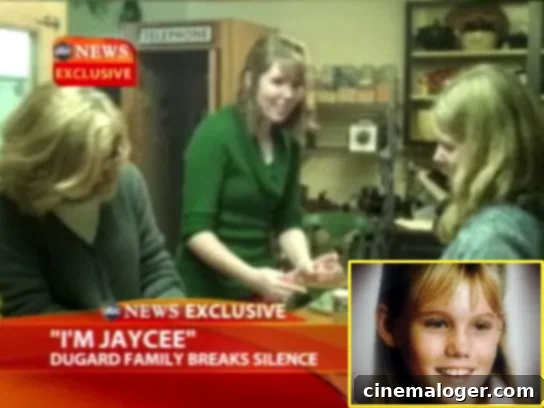Jaycee Dugard: Unpacking the Deeper Reasons Behind Her Public Emergence
The story of Jaycee Dugard, a name that became synonymous with unimaginable resilience, continues to captivate and challenge our understanding of trauma and survival. At 29 years old, Jaycee had already endured a horrific 18-year ordeal, held captive by convicted sex offender Phillip Garrido and his wife. During this harrowing period, she gave birth to two daughters fathered by her captor. Following her dramatic rescue last summer, Jaycee retreated from public view, seeking the solace and privacy necessary for healing. However, a recent decision by Jaycee and her mother, Terry Probyn, to release exclusive home videos to ABC has prompted widespread discussion and raised pertinent questions about the motivations behind her sudden public emergence.
These intimate videos, which first aired on Good Morning America and were followed by more extensive coverage on 20/20 and Nightline, offered a glimpse into Jaycee’s life post-rescue. In the morning segment, Jaycee’s mother earnestly pleaded for privacy, both before and after showing heartwarming footage of Jaycee baking cookies with her 19-year-old half-sister, Shayna. The videos also featured Jaycee herself, a devoted mother to Angel, 15, and Starlit, 11, addressing the camera directly. She expressed gratitude for the public’s overwhelming support, assuring viewers, “I’m doing well.” Yet, the dichotomy between the family’s fervent request for privacy and their decision to release these highly personal videos sparked immediate debate: if privacy is paramount, why are these home videos being shared with the world? And more fundamentally, why is Jaycee now choosing to speak out?
According to image consultant Michael Sands, who has closely followed the intricacies of the Dugard case, there is far more to this situation than initially meets the eye. Sands firmly asserts, “If Jaycee really wanted privacy, she wouldn’t be releasing anything. It’s a smokescreen.” He posits that the underlying motivation is financial, succinctly stating, “She needs M-O-N-E-Y.” Jaycee’s past is one marked by unspeakable horror and prolonged torture, experiences that have left deep, lasting scars. Both she and her daughters will undoubtedly require years, if not decades, of intensive therapy and specialized care to navigate the psychological and emotional aftermath of their ordeal. Such comprehensive support comes with substantial costs, and Sands highlights the family’s current financial constraints, noting that Jaycee is not yet in a position to work. Therefore, securing financial resources is not merely about comfort but about enabling her and her children to access essential long-term support for their healing journey. Furthermore, Jaycee may face complex and emotionally draining legal battles with Phillip Garrido, particularly concerning his potential desire to see their daughters, adding another layer of financial and emotional strain.
Sands estimates that the initial home videos released to ABC could have fetched anywhere between $200,000 and $500,000. He views these video releases as strategic “teasers,” carefully building anticipation for a much larger and more significant venture: a major book deal that would fully unveil her story. The publishing industry, keenly aware of the profound human interest and inspirational power of Jaycee’s narrative, would likely see immense value in her autobiography. Sands speculates that the hardcover rights alone could command over a million dollars. When factoring in paperback rights, international translation rights, film adaptation rights, and future interview opportunities, the total potential earnings for Jaycee could realistically soar to an estimated $10 million. However, he cautions that while the financial potential is vast, Jaycee most probably cannot fully capitalize on a major book deal until the conclusion of her captor’s criminal trial, a legal process that often precedes and influences the timing of victim narratives in the public sphere.
The public’s appetite for Jaycee’s story is multifaceted. Beyond the grim details of her captivity, people are deeply invested in understanding her survival, her resilience, and her path to rebuilding a life. Sands emphasizes that “People will want to read about what happened to her,” believing that her incredible journey will inevitably be adapted into a major motion picture. The upcoming trial of Phillip Garrido is also expected to rivet audiences, drawing significant media attention and public scrutiny. Jaycee’s story transcends mere sensationalism; it is an incredibly powerful and inspirational narrative of survival against unimaginable odds. Her ability to endure, to protect her daughters, and to emerge from such darkness offers a beacon of hope and strength to countless individuals grappling with their own challenges. This profound human interest makes her narrative not only commercially viable but also deeply meaningful to a broad audience.
Jaycee Dugard’s decision to step into the public eye, therefore, appears to be a complex, carefully considered strategy rather than a simple act of personal sharing. It represents a critical step towards securing the financial stability necessary for her and her daughters’ long-term therapeutic needs and future well-being. The public and media’s fascination with her story, while sometimes bordering on intrusive, also presents an opportunity for her to reclaim her narrative, to share her truth on her own terms, and to inspire others with her indomitable spirit. By carefully managing these media appearances and capitalizing on the interest in her experiences, Jaycee is not just telling a story; she is actively funding a new future for herself and her children, a future free from the financial burdens that often accompany such profound trauma. This deliberate approach allows her to transform past suffering into a foundation for healing and empowerment.
Our hearts continue to go out to Jaycee, her resilient daughters, and her steadfast mother. After decades of unspeakable suffering, she profoundly deserves every opportunity to secure her financial future and ensure the comprehensive care and well-being of herself and her family. Her journey is a testament to the human spirit’s capacity for survival and recovery, and we extend our sincerest good wishes to Jaycee as she navigates this challenging yet hopeful new chapter of her life.
—Bonnie Fuller
